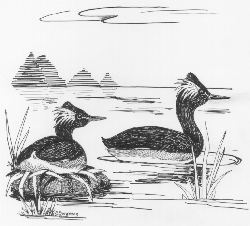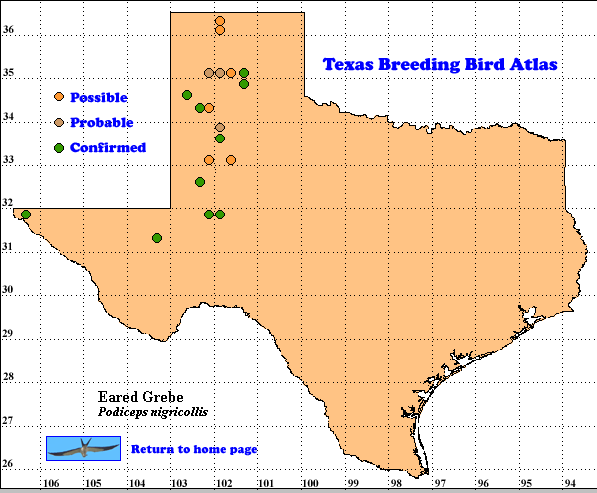Podiceps nigricollis
The Eared Grebe is a common species in appropriate habitat primarily in western temperate North America. Stokes (1996) shows the summer breeding range to be the central and northern Rocky Mountains, the Great Basin, and northern Great Plains in the United States and the Canadian provinces of British Columbia, Alberta, and southern Saskatchewan. Stokes also shows an isolated breeding area on the upper Gulf Coast of Texas.
DISTRIBUTION: Oberholser (1974) reports summer records for the Eared Grebe that are irregular and scattered throughout the state with the prominent exception of the Big Bend region and south Texas where there were none. During the TBBA project (1987-1992) Eared grebes were reported exclusively from the Texas Panhandle, Llano Estacado (Staked Plains), and far west Texas. This represents a significant change in summer distribution. This is comparable to the North American Breeding Survey (Sauer et al.1997) results which show irregular, scattered summer occurrences of the Eared Grebe in the Llano Estacado and Texas Panhandle.
SEASONAL OCCURRENCE: Oberholser (1974) reports the Eared Grebe occurring in Texas during June, July, and August on an irregular basis with extreme dates of 5 June and 19 August. During the TBBA years, extreme dates of 14 May (at latilong 33101-E7; courtship observed) and 7 August (at latilong 34101-H4; fledglings seen) were reported. The only TBBA dates for “nests with eggs” were in June.
BREEDING HABITAT: In Texas, Eared Grebes normally breed in shallow ponds and playa lakes with emergent vegetation, especially around the edges. Oberholser (1974) reports their typical breeding habitat in western North America as the marshy shallow sections of lakes with patchy open water surrounded by emergent vegetation. The grebes nest singly or in colonies. The nest is a floating platform of fresh and decayed vegetation attached to surrounding plants. Clutch size is 3 and 9 dull bluish-white eggs. This agrees with Kaufman’s (1996) summary of the Eared Grebe’s life history except for clutch size; he states that the average number of eggs is 3-5, rarely 1-6.
STATUS: The isolated breeding area on the upper Texas Gulf Coast shown by Stokes (1996) is probably based on Oberholser’s report of breeding records in Bexar, Harris, and Bee Counties in 1916, 1920, 1962, and 1968. Oberholser also reports an isolated breeding record in Wise County in 1889.
As shown by the map, confirmed breeding was observed at ten localities in the Panhandle, Llano Estacado, and west Texas. Fifty-three per cent of the localities shown on the map are confirmed breeding localities. With the exception of El Paso these were single year occurrences at each locality.
Of particular note is the El Paso location (latilong 31106) where there is a permanent resident colony of a few hundred birds (high count of 400 on 2 May 1988). Atlaser Barry R. Zimmer described the specific locality, the Ft. Bliss Sewage Ponds, as still ponds with extensive reed growth along the shorelines and some brush covered islands in the center. This is favorable nesting habitat as described above. In 1988 there were at least 50 breeding pairs at the locality. Dates range from 30 April (perhaps a little earlier than normal) to 25 August, with most initial dates being in May and June. Zimmer reports Eared Grebes have been breeding at the ponds since 1981.
In summary, the Eared Grebe is an uncommon, irregular breeding species in the western half of Texas with the prominent exception of the El Paso area where there is a small permanent breeding colony. There are historical, but no current, breeding records for the upper Texas Gulf Coast.
Text by John Cys (ca. 1998)
Literature Cited
Kaufman, K., 1996. Lives of North American birds. Houghton Mifflin, Boston, NA.
Oberholser, H. C. 1974. The bird life of Texas. University of Texas Press, Austin.
Sauer, J. R., J. E. Hines, G. Gough, I. Thomas, and B. G. Peterjohn, 1997. The North American Breeding Survey results and analysis: Version 96.4. Patuxent Wildlife Research Center, Laurel, MD.
Stokes, D., and L. Stokes. 1996. Stokes field guide to birds: western region. Little, Brown, Boston, MA.

